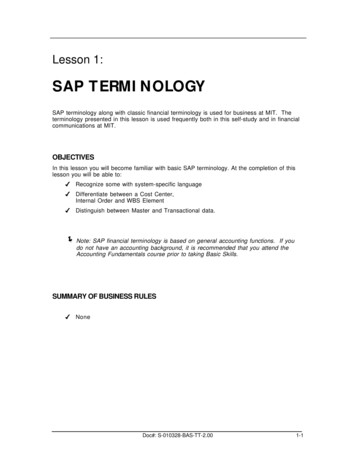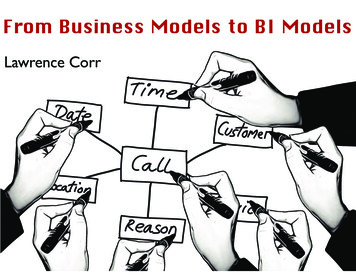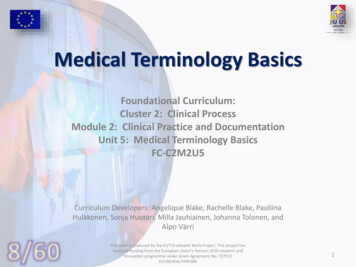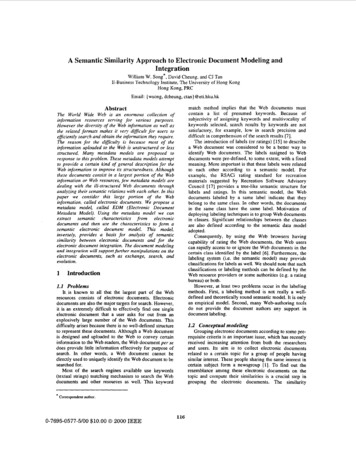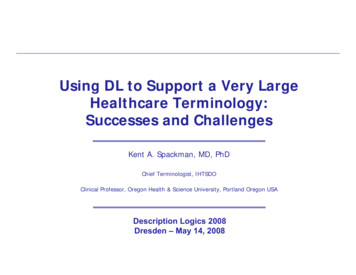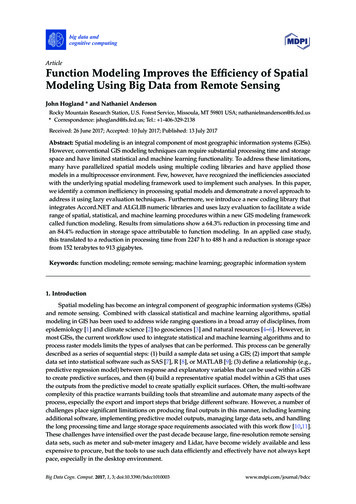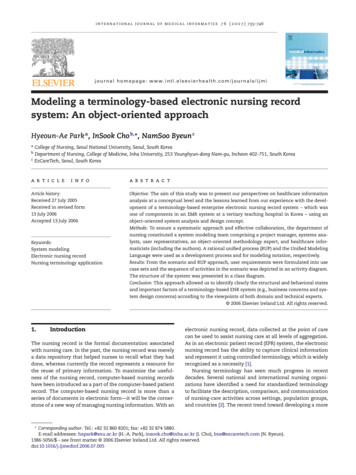
Transcription
i n t e r n a t i o n a l j o u r n a l o f m e d i c a l i n f o r m a t i c s 7 6 ( 2 0 0 7 ) 735–746journal homepage: www.intl.elsevierhealth.com/journals/ijmiModeling a terminology-based electronic nursing recordsystem: An object-oriented approachHyeoun-Ae Park a , InSook Cho b, , NamSoo Byeun cabcCollege of Nursing, Seoul National University, Seoul, South KoreaDepartment of Nursing, College of Medicine, Inha University, 253 Younghyun-dong Nam-gu, Incheon 402-751, South KoreaEzCareTech, Seoul, South Koreaa r t i c l ei n f oa b s t r a c tArticle history:Objective: The aim of this study was to present our perspectives on healthcare informationReceived 27 July 2005analysis at a conceptual level and the lessons learned from our experience with the devel-Received in revised formopment of a terminology-based enterprise electronic nursing record system – which was13 July 2006one of components in an EMR system at a tertiary teaching hospital in Korea – using anAccepted 13 July 2006object-oriented system analysis and design concept.Methods: To ensure a systematic approach and effective collaboration, the department ofnursing constituted a system modeling team comprising a project manager, systems ana-Keywords:lysts, user representatives, an object-oriented methodology expert, and healthcare infor-System modelingmaticists (including the authors). A rational unified process (RUP) and the Unified ModelingElectronic nursing recordLanguage were used as a development process and for modeling notation, respectively.Nursing terminology applicationResults: From the scenario and RUP approach, user requirements were formulated into usecase sets and the sequence of activities in the scenario was depicted in an activity diagram.The structure of the system was presented in a class diagram.Conclusion: This approach allowed us to identify clearly the structural and behavioral statesand important factors of a terminology-based ENR system (e.g., business concerns and system design concerns) according to the viewpoints of both domain and technical experts. 2006 Elsevier Ireland Ltd. All rights reserved.1.IntroductionThe nursing record is the formal documentation associatedwith nursing care. In the past, the nursing record was merelya data repository that helped nurses to recall what they haddone, whereas currently the record represents a resource forthe reuse of primary information. To maximize the usefulness of the nursing record, computer-based nursing recordshave been introduced as a part of the computer-based patientrecord. The computer-based nursing record is more than aseries of documents in electronic form—it will be the cornerstone of a new way of managing nursing information. With an electronic nursing record, data collected at the point of carecan be used to assist nursing care at all levels of aggregation.As in an electronic patient record (EPR) system, the electronicnursing record has the ability to capture clinical informationand represent it using controlled terminology, which is widelyrecognized as a necessity [1].Nursing terminology has seen much progress in recentdecades. Several national and international nursing organizations have identified a need for standardized terminologyto facilitate the description, comparison, and communicationof nursing-care activities across settings, population groups,and countries [2]. The recent trend toward developing a moreCorresponding author. Tel.: 82 32 860 8201; fax: 82 32 874 5880.E-mail addresses: hapark@snu.ac.kr (H.-A. Park), insook.cho@inha.ac.kr (I. Cho), bns@ezcaretech.com (N. Byeun).1386-5056/ – see front matter 2006 Elsevier Ireland Ltd. All rights reserved.doi:10.1016/j.ijmedinf.2006.07.005
736i n t e r n a t i o n a l j o u r n a l o f m e d i c a l i n f o r m a t i c s 7 6 ( 2 0 0 7 ) 735–746rigorous foundation for nursing terminology brings with itseveral potential benefits, including greater expressivenessand more extensive reuse of data from heterogeneous sources[3–5].However, the existence of appropriate terminology for capturing nursing information does not necessarily solve theproblem of how the information will be transformed fromconcepts in the nurses’ minds to codes in the computer’sdatabase. Users of existing nursing information systems typically enter and retrieve structured data using so-called interface terminologies–terminologies that are optimized for enduser utilization, such as menu-driven data entry [6]. Theseterminologies generally take the form of enumerated classifications, such as the North American Nursing DiagnosisAssociation Taxonomy I. But it is now recognized that thesetypes of terminologies may not be able to represent clinicalinformation in sufficient detail [5,7,8] nor provide sufficientcoverage [9]. The International Classification for Nursing Practice (ICNP) developed by International Council of Nurses (ICN),which is a combinatorial terminology, represents one attemptto address some of the problems associated with these traditional representations. However, the combinatorial nature ofthe ICNP makes it difficult to use directly, and this now appearsto represent a barrier to acceptance by nurse users [5].This article describes how object-oriented analysis anddesign can be used in developing and implementing aterminology-based electronic nursing record system (ENRS).Here we describe how to design domain models and implement a model database that allows greater expressiveness andreuse of data. In addition, this study can be used to improvea multidisciplinary development team’s understanding of thefunctions and data processing procedures in the design anddevelopment stage, as well as of future maintenance procedures. We also describe the issues and lessons learned throughthis modeling process.2.Background2.1.The initiation of an ENRS designIn 2002, the Department of Nursing at the Seoul National University Hospital, a tertiary teaching hospital with 1500 beds inKorea, initiated work on designing an ENRS that was plannedas part of the development of a paperless electronic medical record (EMR) system for a new branch hospital with 900beds to be opened in May 2003. An ad hoc committee with sixnurse managers was formed to decide important issues suchas the controlled vocabulary, the nursing information model,and the user interface views. The committee recognized thatthe primary objective of an ENRS is to help nurses to manage apatient’s trajectory by tracing care activities and documentingall the events of the care processes.The committee decided to use standard nursing terminology in order to support multipurpose applications of nursingdata such as quality improvement, decision support, and comparison of nursing services. The ICNP beta version developedby the ICN was selected as the standard nursing terminologydue to its expressiveness and flexibility.A nursing information model using a standard terminologywas designed and tested by the authors through the previous study [10]. Fig. 1 shows the conceptual data flow betweenthe front-end and back-end of an ENRS. The upper part ofthe figure presents the content of nursing records expressedFig. 1 – Nursing information model for an electronic nursing record system (ENRS).
i n t e r n a t i o n a l j o u r n a l o f m e d i c a l i n f o r m a t i c s 7 6 ( 2 0 0 7 ) 735–746737Table 1 – Nursing data views for an electronic nursing record systemData viewAdmission nursing assessmentGraphic recordFlow sheetNursing notesPreoperative check listNursing discharge planOperating room nursing recordNursing order check listInformation contentTarget nursing unitDemographics, admission information, history(health, illness, family, obstetric, menstruation,and immunization), physical assessment, andeducationVital signs, admission or post-operation day,bowel movements, diet, activity, and input andoutputVital signs, admission or post-operation day,diet, position, input and output, medication,ventilator settings, signs and symptoms ofrespiration, gastrointestinal tract, wounds,consciousness, and skin integument, laboratory,and imaging testsNursing processPatient ID, nursing activities, and educationDischarge care plan, medication education, andfuture appointmentsOperating room staff, procedures, operatingtime, anesthesia, materials used, and medicationNursing ordersInpatient unitsInpatient unitsIntensive care units: MICU, NICU, SICU, and RICUInpatient and outpatient unitsSurgical, and obstetric and gynecologic unitsInpatient unitsOperating roomInpatient unitsMICU, NICU, SICU, and RICU stand for medical intensive care unit, neonatal intensive care unit, surgical intensive care unit, and respiratoryintensive care unit, respectively.according to the nursing process. Core nursing data shouldbe captured through the nursing process, which encompassesfragmented types of nursing documentation in various structured and unstructured forms. The lower part of the figurepresents the components and roles of a terminology serverand a clinical data repository.A terminology server manages three types of controlled terminology: clinical, administrative, and reference. In this study,the ICNP beta version was used as the reference terminology in the form of controlled nursing statements consistingof three data categories: nursing diagnosis, nursing activities,and nursing outcomes. These statements were used by theend users to populate the clinical terminology during directdata entry. These data categories are generated by terminology managers through semantic combinations of the ICNPconcepts—these are referred to as precoordinated statements.The administrative terminology is a subset of the clinical terminology that is used for statistical classifications and datacomparisons across heterogeneous representations; examples are the NANDA Taxonomy, the Clinical Care Classification,and the Nursing Interventions Classification. The administrative terminology contains more abstractive and aggregatedterms, and is used for analyzing and summarizing the clinicaldata in the repository of an EMR system. However, it can alsobe used for clinical terms; the NANDA Taxonomy is an example that can be used for the clinical terms in a list of nursingdiagnosis in the nursing record.Based on the above information model, 69 nursing formsfrom 62 nursing units were analyzed to identify the type ofinformation being documented. The structured forms wereanalyzed using a data matrix based on data items. We foundmany similarities and a few difference between the forms.For example, seven different types of forms were used torecord admission nursing assessments: basic demographics(e.g., name, age, sex, ID number, and address), health history,family history, admission information, physical assessment,and admission education were recorded in all forms; whereasbirth history, immunization schedule, obstetric history, andpsychological history were only included in some of the forms.We derived an interface with eight data views encapsulatingthe existing 69 nursing forms by considering these similaritiesand differences (Table 1).2.2.Object-oriented system designIn software development, there are several ways to develop amodel. The two most common approaches are from an algorithmic perspective and from an object-oriented perspective.The traditional view takes an algorithmic approach, in whichthe main building block is the procedure or function. Thisview leads the developer to focus on issues of control and thedecomposition of larger algorithms into smaller ones. However, changes in requirements and system growth make it veryhard to maintain systems built with an algorithmic focus.The contemporary view of software development takes anobject-oriented perspective. In this approach, the main building block is the object or class. An object is generally drawnfrom the solution space, and a class is a description of a setof common objects. Every object is characterized by its identity, state (i.e., there is normally some data associated with it),and behavior. This approach has become mainstream simplybecause it has proven effective in building systems in all sortsof problem domains and encompassing all degrees of size andcomplexity [11].In traditional health information system design, clinicaldata and the rules for manipulating the data are built withinthe applications. As the same set of data might need to beshared by clinicians with various professional orientations,different software modules of the system were created toaccess and manipulate the same data [12,13]. Often multi-
738i n t e r n a t i o n a l j o u r n a l o f m e d i c a l i n f o r m a t i c s 7 6 ( 2 0 0 7 ) 735–746ple copies of the same data are created for convenience, or asa result of undisciplined programming practices. When datais manipulated by different program modules operating withdifferent business process, inconsistencies in or corruption ofthe data are not uncommon. The level of program complexityand the extra efforts required to maintain data consistencyinevitably result in high costs [14].The above factors mean that the data must be clearly separated from the applications that manipulate them. This isachieved by allocating the data to a specific class of dataobjects that protects it, and the application of the data abstraction (encapsulating and information hiding) principle. Thisapproach ensures the entrusted data as well as an object’sbehaviors are hidden from the users and other objects. Objectsuse messages (commands) to invoke methods (functions) toperform various operations that may produce a change in theobject’s state (attributes or data values). Only the methods ofan object have access to the members of its data set. Limitingthe access to and manipulation of data through the ‘authorized’ object and its methods ensures their accuracy and consistency. The properties of data abstraction, inheritance, andpolymorphism, and the ability of objects to effectively modelthe complexity of the real world make the object-orientedtechnique well suited to the design and development of complex applications [15]. These advantages of object-orientedtechnique prompted us to adopt this technique in the presentstudy.3.Methods3.1.The Unified Modeling Language and the rationalunified processVisualizing, specifying, constructing, and documenting a software system requires the system to be viewed from severalperspectives. Different stakeholders – nurses, nurse managers, analysts, developers, system integrators, and projectmanagers – each bring different agendas to a project, and eachlooks at the ENRS in different ways at different times over thelife of the system.To keep the analysis, design, implementation, and maintenance of an ENRS manageable, the system as well as itsunderlying concepts has to be formalized and systematizedusing modeling techniques, in which basic components andconcepts can be defined for ease of use and to enable the formation of a comprehensive real-world system. For optimizedsolutions, the system should be viewed from enterprise, information, computational, engineering, and technology perspectives. The availability of such views facilitates the involvementof the different stakeholders and ensures the implementationof the needs of the users. This study defined such modelsand employed methodologies such as the Unified ModelingLanguage (UML) so as to appropriately specify the system components and their behavior.The UML was selected in 1997 as a standard notation bythe Object Management Group out of the various methodologies related to object-oriented technology [16–18]. Booch,Rumbaugh, and Jacobson initiated the UML, and proposed arational unified process (RUP) as a development process thatcould take full advantage of the UML. They suggested thatthe UML is not a standard for the development process, buta standard for the artifacts of development (semantic models,syntactic notation, and diagrams). The RUP captures the bestpractices in modern software development in a form that canbe adapted to a wide range of projects and organizations.The above-mentioned features lead us to adopt the RUP asour project methodology. The RUP has four phases: inception,elaboration, construction, and transition. During elaboration,it is necessary to acquire a good grasp of the requirements andestablish an architectural baseline as a development standardfor the construction phase. During construction, the productis built up – often in several iterations – to the beta release.In the transition phase, the product is transited to the enduser and the project focus moves to end-user training, installation, and support. The RUP is a model-driven approach, andseveral models are needed to fully describe the evolving system. The scope of this paper is limited to two iterations ofthe elaboration phase (Fig. 2). Therefore, we used use casemodels to identify what the system is supposed to do andthe system environment. We then identified the class diagrams as a design model describing the realization of the usecases.For the two models of use case and design, four artifactswere used: use case diagram, use case description, activitydiagram, and class diagram. For the effective application ofthe RUP and an accurate extraction of requirements, a modeling team was formed comprising a project manager, systems analysts, user representatives, and nursing informaticists. The project manager was responsible for identifying thedata flow and interface problems between the ENRS and otherrelevant systems. The system analysts and nursing informaticists identified user requirements through regular meetingswith user representatives. User representatives consisted ofnine nurse managers from six major nursing units: internal medicine, general surgery, intensive care unit, gynecology, pediatrics, and special surgery; they identified the userrequirements in consultation with the authors.3.2.Modeling artifacts and specificationWe selected a scenario approach to extract user requirements.We wrote a scenario designed to highlight the functional areaof focus (nursing note taking) within the specified operationalenvironment (nurse station) and time frame (recently). Afterobtaining approval for the scenario, we drafted a scenariostory based on an adaptation of one of the many such storiesavailable. We defined a scenario story as a probable sequenceof activities within our scenario. An excerpt of our scenariostory for the above scenario is provided below. Our scenariostory consisted of short structured sentences. The structure ofour paragraphs centered on the actions of a nurse over a shorttime period. The nurse’s actions within each paragraph werealways directed toward a single purpose. At the scenario storymatured, we drew a scenario activity diagram that depictedthe sequence of activities in the scenario story. Activitiesthat resulted in information exchange were identified anddrawn, and story actions were mixed with these informationexchanges as necessary to provide context. The principleobjective of the scenario activity diagram was to depict
i n t e r n a t i o n a l j o u r n a l o f m e d i c a l i n f o r m a t i c s 7 6 ( 2 0 0 7 ) 735–746739Fig. 2 – The rational unified process and the scope of this project.instances of information exchange to aid in the identificationof potential use cases.We formulated use cases using these scenarios, with theuse cases for a given scenario defined as a use case set.We recognized that use case sets for a given scenario varied across operational environments and time. Operationalenvironments could include such entities as inpatient andambulatory departments. A use case describing a nurse’s useof a computer could involve the use of a handheld computerat the bedside of a patient. Use case sets for a given scenarioalso change with time, such as an increasing trend towardvoice data entry as the technology emerges. The use case setreported here corresponded to a tertiary teaching hospital during 2003.After formulating use cases, we identified classes andtheir relationships (which is one of the cornerstones of theobject-oriented approach). Here we report on the class diagrams, which are divided into internal and external views.The external view contains external elements that correspondto the people and things engaged in information exchangeoutside the ENRS, whereas the internal view contains only elements from the ENRS. An object-oriented methodology expertreviewed modeling products and provided progressive feedback to the research team. This approach helped the team tolook at the real world with object concepts and to describe thesystem whilst following the RUP.4.Results4.1.Use case viewThe use case view describes the behavior of the ENRS as seenby a nurse, a nurse manager, and a physician. The staticaspects of this view were captured in a use case diagram(Fig. 3).The use case diagram comprised eight use cases addressingrecord management and six use cases addressing nursing terminology management. The part devoted to the managementof nursing terminology was specialized to the ICNP Term Management use case, Statement Management use case, and threeother use cases supporting functions of terminology management. Physician, Nurse, and Nursing Term Manager were identified as the actors that use these use cases. The Physician isan actor who also represents other healthcare professionalsthat need to refer to nursing documents, such as nutritionists, pharmacists, radiation therapists, and staff of the insurance department. The Nurse (including the nurse manager)is an actor who participates in writing nursing documents,and supervises them for service quality assurance. The Nursing Term Manager is an actor that takes charge of terminologymanagement, including the ICNP concepts and controlled precoordinated statements.The dynamic aspects of use case view were captured in anactivity diagram (as shown in Fig. 4) that describes the flowbetween activities within the ENRS. The overall task flow ofthe ENRS was identified in the activity diagram. The NursingTerm Manager is in charge of creating, updating, and maintaining nursing terminology, and controlling the precoordinatedstatements that the nurse uses in the data input process. Theadministrative terms identified by the Nursing Term Managerare used in the analysis of nursing records for the variouspurposes of data aggregation. For example, the chief nursemanager of the internal medicine department may want toretrieve the nursing diagnosis and the nursing activity listsidentified in patients admitted to the oncology nursing unitduring specified periods. He or she will use such information to understand trends in nursing problems or to distribute
740i n t e r n a t i o n a l j o u r n a l o f m e d i c a l i n f o r m a t i c s 7 6 ( 2 0 0 7 ) 735–746Fig. 3 – Use case diagram of the ENRS.
i n t e r n a t i o n a l j o u r n a l o f m e d i c a l i n f o r m a t i c s 7 6 ( 2 0 0 7 ) 735–746741Fig. 4 – Activity diagram of the ENRS.nursing resources during subsequent time periods. The ENRSretrieves the nursing problems and activities under the givenconditions, and returns the result in abstracted forms usingadministrative terms. It is a common task for managers touse these aggregating functions. The role of the Physician issimply retrieving and inquiring functions through the varioususer interface displays.Use case specifications were documented from scenariostories and identified use case properties. Use case specifications include the name, a brief description, the eventflows, alternative flows, special requirements, and the preand postconditions. Each flow of events was described innarrative form. Fig. 5 shows a part of specification for theNursing Notes use case. In this specification, the event flowscomprise the normal data input, update, and delete scenario, while alternative flows contain exceptional scenarios including incomplete data input, data errors, and network errors. The special requirements address items suchas authorizations and logging events of deletions and modifications to the statements in the database. Also constraints such as those listed below (an example of a Nursing Notes use case description) were identified as pre- andpostconditions: The authorization required to add, modify, or delete arecord. The system logs for tracing changes to a record. The requirement for a digital signature for legal reasons.4.2.Design viewThe design view supports the functional requirements of thesystem, which are the services that the system should provide to its end users. With the UML, the aspects of this viewwere captured in electronic nursing record class diagrams. Theuse cases of the ENRS can be divided functionally into twopackages, Nursing Records and Nursing Term Management, whereeach package includes a Nursing Records class diagram and aNursing Term Management class diagram.Fig. 6 shows the class diagram for four types of nursing data views: ‘admission nursing assessment’, ‘graphicrecord’, ‘nursing notes’, and ‘flow sheet’. This diagram consistsof seven entity classes, four boundary classes, four controlclasses, and their interrelationships. Eight entity classes thatare applicable to each nursing data view are also includedin this diagram. The classes used to store patient data wereomitted from Fig. 6 in order to decrease the complexity of thefigure. In this diagram, entity, boundary, and control classesare used for a database table schema, user interface, and dataprocessing, respectively. Each boundary class requests specificoperations related to control classes, and then each controlclass manipulates the data received from the related entityclasses.The four use cases correspond to the classes of InitialAssessment, Vital sign Sheet, Nursing Notes, and ICU NursingRecord, respectively, in the class diagram. The Initial Assessmentclass is representative for the other three use cases of ‘preoper-
742i n t e r n a t i o n a l j o u r n a l o f m e d i c a l i n f o r m a t i c s 7 6 ( 2 0 0 7 ) 735–746Fig. 5 – Partial example of a Nursing Notes use case description.ative check list’, ‘nursing discharge plan’, and ‘operating roomnursing record’, because the classes for the three use casesare driven dynamically from the class of Nursing Record Itemsin the same way as for the Initial Assessment class. However,the classes for ‘graphic record’ and ‘flow sheet’ have fixed dataitems and are separated into the Nursing Record Item Selection,Vital sign Sheet, and ICU Nursing Record classes. The ‘nursingnotes’ case uses the Statement class directly. The class for a‘nursing order check list’ is not shown in this diagram becauseits data items come from the physician order contained in aphysician order entry system that is external to the ENRS.In the notation of the UML, the rectangles of Fig. 6 provideinformation about each class. The top tier in each rectanglecontains the name of the class, and the middle tier containsthe member items identified in the use cases. Member itemsare not synonymous with the data elements of a databaseschema–data elements are more detailed and discrete thanmember items in this project.The class diagram of Fig. 7 consists of six entity classes,three boundary classes, four control classes, and their interrelationships. The ICNP Terminology and Statement classes referto the ICNP beta version and controlled statements populatedfrom the ICNP, respectively. The ICNP Attributes class is introduced to increase the expression granularity of a controlledstatement, and is predefined as properties for each concept.For instance, the concept of ‘body temperature’ could havethe value of body temperature and the site of measuring as itsattributes. These attributes are used when a controlled state-
i n t e r n a t i o n a l j o u r n a l o f m e d i c a l i n f o r m a t i c s 7 6 ( 2 0 0 7 ) 735–746Fig. 6 – Class diagram of the Nursing Records package.Fig. 7 – Class diagram of the Nursing Term Management package.743
744i n t e r n a t i o n a l j o u r n a l o f m e d i c a l i n f o r m a t i c s 7 6 ( 2 0 0 7 ) 735–746Table 2 – Example of recording a patient’s level of consciousness based on the design and implementation levels of themodelDesign level (entity class)Implementation levelDatabase tableTuples of field name and valueNursing Record ItemStatementNursing Record ItemStatement. . ., (Item ID, 1234), (Item, ‘consciousness’), . . ., (Statement ID, 5678), . . . . ., (Statement ID, 5678), (Statement Name, ‘observe consciousness’),(Statement Type, ‘activities’), . . .ICNP Statement MapICNP Statement Mapa(ICNP ID, 1111), (Statement ID, 5678), . . .(ICNP ID, 2222), (Statement ID, 5678), . . .ICNP TerminologyICNP Terminologya(ICNP ID, 1111), (English Name, ‘observing’), . . .(ICNP ID, 2222), (English Name, ‘consciousness’), . . .ICNP AttributesICNP Attributesa(ICNP ID, 1111), (Attribute ID, E999), (‘Attribute Name, ‘’), . . .(ICNP ID, 2222), (Attribute ID, 4444), (Attribute Name, ‘Level’),(Attribute Type, string), . . .Admission Nursing AssessmentAdmission Nursing Assessment(Patient ID, 888888), . . . (Item ID, 1234), (Statement ID, 5678),(Attribute01, ‘alert’), (Attribute02, ‘’), (Attribute03, ‘’), . . .aIndicates entries with two corresponding records. The field name of each unique ID is assigned randomly in this example.ment precoordinated with the concept of ‘body temperature’is selected. The Statement Tree class is introduced to help navigate the statements in each nursing unit.Given these two class diagrams, the database schemamight be designed in one of several different ways in theimplement phase. As an example, Table 2 indicates the information flow for a user wanting to enter the value of ‘level ofconsciousness’ of a patient at the view of ‘admission nursingassessment’.5.Discussion and conclusionsThe current widespread use of SNOMED clinical terms inelectronic medical records marks a shift in emphasis awayfrom the notion of a mere ‘reference terminology’ towards aterminology sys
Nursing terminology has seen much progress in recent decades. Several national and international nursing organi-zations have identified a need for standardized terminology to facilitate the description, comparison, and communication . international journal of medical informatics 76(2007)735-746 737 Table 1 - Nursing data views for an .
